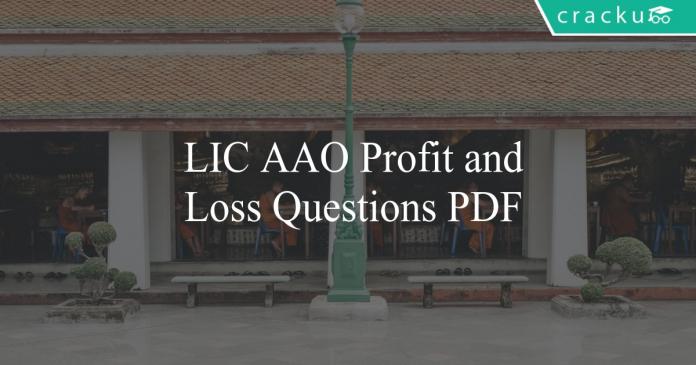LIC AAO Profit and Loss Questions PDF
Download Important Profit & Loss questions for LIC AAO exam. Top 20 English Profit & Loss questions with answers based on previous year asked questions.
Download LIC AAO Profit & Loss Questions PDF
Take a free mock test for LIC AAO
Download LIC AAO Previous Papers PDF
Question 1: A, B, C started a shop by investing Rs. 27000, Rs. 81000 and Rs. 72000 respectively. At the end of one year, B’s share in total profit was Rs. 36000. What was the total profit ?
a) Rs. 108000
b) Rs. 116000
c) Rs. 80000
d) Rs. 92000
Question 2: A dealer offers a discount of 10% on the marked price of an article and still makes a profit of 20%. If its marked price is Rs. 800, then the cost price is:
a) Rs. 600
b) Rs. 700
c) Rs. 800
d) Rs. 900
Question 3: By selling a table for Rs. 350 instead of Rs. 400, loss percent increased by 5%. The cost price of table is:
a) Rs. 435
b) Rs. 417.50
c) Rs. 1000
d) Rs. 1050
Download LIC AAO Previous Papers PDF
100 Free Computer Awareness Tests for LIC
Question 4: If the manufacturer gains 10%, the wholesale dealer 15% and the retailer 25%, then the cost of production of an article whose retail price is Rs. 1265, is:
a) Rs. 632.50
b) Rs. 800
c) Rs. 814
d) Rs. 834.34
Question 5: A seller allows a discount of 5% on a watch . If he allows a discount of 7%, he earns Rs. 15 less in the profit What is the marked price ?
a) Rs. 697.50
b) Rs. 712.50
c) Rs. 750
d) Rs. 817.50
Question 6: Ram bought 1600 eggs at Rs. 3.75 per dozen. He sold 900 of them at 2 for Re.1 and the remaining at 5 for Rs. 2. His gain per cent is:
a) 40%
b) 45%
c) 42%
d) 46%
Question 7: A man gets Rs. 60 more if he sells an article at 20% gain in comparison to selling it at 20% loss. What is cost price of article ?
a) Rs. 140
b) Rs. 150
c) Rs. 160
d) Rs. 180
e) None of these
100 Free GK Tests for Insurance Exams
Question 8: If an article is sold for Rs. 1320, a loss of 12% incurs. What is the cost price of the article ?
a) Rs. 1480
b) Rs. 1520
c) Rs. 1450
d) Rs. 1500
e) None of these
Question 9: Mehul sold an item for Rs. 5.025 and incurred a loss of 25% At what price should he have sold the item to have gained a profit of 25% ?
a) Rs. 8.375
b) Rs. 10,500
c) Rs. 8,250
d) Cannot be determined
e) None of these
Question 10: The cost price of an item is two-third of its selling price. What is the gain/loss percent on that item?
a) 45
b) 50
c) 35
d) 54
e) None of these
LIC AAO REASONING QUESTIONS PDF
Question 11: A seller offered 25% discount on the TVs and as a result, the sales increased by 60%. What is the effect on his revenue?
a) Decrease of 10%
b) Decrease of 20%
c) Increase of 20%
d) Increase of 10%
e) None of these
Question 12: A shopkeeper offers a discount of 30% of a certain article and still manages to earn a profit of 12%. What discount should he offer if wants to earn a profit of 4 percent?
a) 60 %
b) 90 %
c) 40 %
d) 45 %
e) 35 %
Question 13: A shopkeeper buys a phone for Rs. 1000 and marks up the price by n%. He further offers a discount of 30% and makes 2% loss. Find n.
a) 25
b) 33
c) 47
d) 40
e) 32
Question 14: Cost price of pen and eraser is Rs. 10 and Rs 5 respectively. A shopkeeper sells eraser at 10% profit and pen at 20% profit. A customer takes away 50 pen and 100 eraser, what will be the total profit/loss for the shopkeeper, if he gives 5 pen free for every 20 pen 1 eraser free for every 9 erasers?
a) Rs 25 profit
b) Rs 25 loss
c) Rs 50 loss
d) Rs 50 profit
e) No profit, No loss
Question 15: A cunning shopkeeper selling pulses uses 2 separate weighing machines M1 and M2. While buying, he uses M1 which is calibrated to show 1000 gms instead of 1200 gms and while selling, he uses M2 which has been calibrated to show 1000 gms instead of 800 gms.If he claims to sell at cost price, what is his overall profit percentage?
a) 20%
b) 30%
c) 40%
d) 50%
e) 60%
Question 16: A shopkeeper marks up the goods by 100 percent. He sells it at a certain discount and still earns a profit of 25 percent. Now the cost price of the good comes down by 25 percent but the shopkeeper continues to keep the same marked price and discount. What will be his profit under the new conditions?
a) 50 %
b) 40 %
c) 66.67 %
d) 75 %
e) 33.33 %
Question 17: A, B and C start a small business. A contributes 1/5th of the total capital invested in the business. B contributes as much as A and C together. Total profit at the end of the year was Rs. 5,200. What was C’s profit share ? (in Rupees)
a) 1510
b) 2510
c) 1500
d) 2560
e) 1560
Question 18: A wholesaler blends two varieties of tea, one costing Rs. 60 per kilogram and another costing Rs. 105 per kilogram. The respective ratio of quantities they were mixed in was 7 : 2. If he sold the mixed variety at Rs. 100 per kilogram, how much was his profit percentage ?
a) $34\frac{2}{7}$
b) $38\frac{2}{5}$
c) $32\frac{2}{5}$
d) $42\frac{6}{7}$
e) $48\frac{6}{7}$
Question 19: The cost price of item B is Rs. 150/- more than the cost price of item A. Item A was sold at a profit of 10% and item B was sold at a loss of 20%. If the respective ratio of selling prices of items A and B is 11 : 12, what is the cost price of item B?
a) Rs. 450/-
b) Rs. 420/-
c) Rs. 400/-
d) Rs. 350/-
e) Rs. 480/-
Question 20: A article whose cost price is 800 was sold at a loss of 20 percent. The shopkeeper who sold the article had offered a discount of 36 percent. What should be the percentage change in the marked price if the shopkeeper wants to make a profit of 20 percent while offering no discount?
a) 4 % increase
b) 4 % decrease
c) 10 % increase
d) 10 % decrease
e) 12 % increase
Download General Science Material PDF
Answers & Solutions:
1) Answer (C)
A, B and C will recieve profits in proportion to their investments.
Now, their investments are in the ratio 3:9:8
Let the common multiple be x.
Now, B’s share = 36000
Therefore, (9/20)x = 36000
x = 80,000
The correct option is option C.
2) Answer (A)
Dealer has offered a discount of 10% on his marked price of 800.
Therefore, selling price = 800 – 80 = 720
Percent Profit = $\frac{Selling Price – Cost Price}{Cost Price}$*100
0.2 = $\frac{720 – Cost Price}{Cost Price}$
Cost Price = 720/1.2
Cost Price = 600
Therefore option A is correct.
3) Answer (C)
We known that,
Loss Percent = $\frac{Cost Price – Selling Price}{Cost Price}$
Let Cost Price be x.
Now,
Difference in percent loss will be 5%.
$\frac{x-350}{x}$ – $\frac{x-400}{x}$ = 0.05
50/x =0.05
x= 1000
Therefore, the correct option is option C.
4) Answer (B)
Let x be the production cost of the article.
Now, 1.1*1.15*1.25*x = 1265
x = (1265/1.1*1.15*1.25)
= 800
Therefore, the production cost of article is 800
Therefore, option B is correct.
5) Answer (C)
We know that,
Profit = Selling Price – Cost Price
Now, let the marked price be x
As per given condition,
(0.95x – Cost Price) – (0.93x – Cost Price) = 15
0.02x = 15
x = 750
Therefore, the correct option is option C.
6) Answer (D)
Total cost price of all 1600 eggs = (1600/12)*3.75 = 500
Now, 900 eggs were sold for 2 eggs for Re 1 or 1 egg for Rs.0.6. Hence selling price of 900 eggs = 0.5*900 = 450
Also, remaining 700 egs were sold for 5 eggs at Rs. 2 or 1 egg at Rs.0.4, their selling price = 700*0.4 = 280
Now, total selling price for 1600 eggs = 450+280 = 730
Percent Profit = $\frac{730-500}{500}$= 46
Therefore, the correct option is option D.
7) Answer (B)
8) Answer (D)
9) Answer (A)
Mehul Selling Price = Rs.5.025
Loss = 25%
Using S.P=C.P(1-(loss/100)) ,
We get S.P = 0.75C.P
=> C.P = Rs.6.7
Now again,
S.P=C.P(1+(profit/100))
Profit=25 % and C.P.=6.7
We get S.P = 1.25*6.7
S.P=Rs. 8.375
Option A is the right answer.
10) Answer (B)
Given that ,
Cost price (cp) = $\frac{2}{3}$ selling price(sp)
- Clearly, selling price is more than cost price. Hence it is a GAIN .
- Gain% = [(sp – cp)/ cp] * 100
- = [(sp/cp) -1] * 100
- = ($\frac{34}{3}$ – 1 ) * 100
- = 50
11) Answer (C)
Let the initial SP be 100x and sales be 100y
Revenue = 100x * 100y = 10000xy
Now,
SP = 75x and sales = 160y
Revenue = 75x * 160y = 12000xy
% increase = (2000xy/10000xy) * 100= 20%
Hence, C is the correct answer.
12) Answer (E)
Let the CP be 100. So the SP will be 112. But this is obtained after offering 30 percent discount. Hence, MP = 112/.7 = 160.
Thus, if the shopkeeper wants to make a profit of 4 percent, then he should offer a discount of 56 rupees.
Thus, percentage discount = 56*100/160 = 35%
Hence, the discount should be 30%.
13) Answer (D)
He makes a loss of 2%, which is Rs. 20.
The selling price = 980
1000* (1 + n/100) * 0.7 = 980
1 + n/100 = 1.4
n = 40
14) Answer (B)
Total cost price would be equal to 50*10 + 5*100 = 1000 Rs. To take away 50 pens, the shopkeeper must sell 40 pens, since remaining 10 would be free. Similarly to take away 100 erasers, the shopkeeper must sell 90 erasers as 10 erasers will be given free. Selling price of each pen will be 12Rs and each eraser will be 5.5Rs. So total selling price = 12*40 + 5.5 *90 = 480 + 495 = 975. So the loss will be (1000-975) = 25Rs. Hence option B is the right choice.
15) Answer (D)
Let us assume that the shop keeper buys 1200 gms for Rs. 100. He will sell 1200 gms for Rs. 100 + Rs. 50 (800 gms + 400 gms). He buys at Rs. 100 and sells at Rs. 150 earning a total profit of 50%.
16) Answer (C)
Let the CP of the product be 100.
Hence, the marked price will be 200 and SP will be 125. Now the marked price comes down by 25 percent. Hence, the new marked price will be 100*.75 = 75
The selling price is still 125. Hence, the required profit percentage will be
(125 – 75)*100/75 = 66.67%
17) Answer (E)
Let total contribution by A,B and C be’5x’.
A’s contribution=$\frac{1}{5}\times5x$.
=x.
Let B’s contribution be ‘y’
A’s contribution+B’s contribution+C’s contribution=5x.
x+y+C’s contribution=5x.
C’s contribution=4x-y.
It is given that,
A’s contribution+C’s contribution=B’s contribution.
x+4x-y=y.
5x=2y.
A’s contribution=x.
B’s contribution=5x/2.
C’s contribution=4x-5x/2=3x/2.
A’s contribution:B’s contribution:C’s contribution=$1:\frac{5}{2}:\frac{3}{2}$
=2:5:3.
Since time for contribution is same, therefore, their profit share must be in ratio of their contribution.
Total profit=5200.
C’s profit=$\frac{3}{10}\times5200$.
=1560.
Hence, Option E is correct.
18) Answer (D)
Let wholesaler mixed 7 kg and 2 kg of tea of variety 60 Rs/kg and 105 Rs/kg respectively.
Cost of tea of variety 60 Rs/kg=$60\times7$.
=Rs. 420.
Cost of tea of variety 105 Rs/kg=$105\times2$.
=Rs. 210.
Total cost=420+210.
=630.
Selling price=$9\times100$.
=900.
Profit percentage=$\frac{900-630}{630}\times100$.
=$\frac{300}{7}$.
=$42\frac{6}{7}$.
Hence, Option D is correct.
19) Answer (A)
CP of B = CP of A +150
SP of A = 1.10 $\times$ CP of A
SP of B = 0.8 $\times$ CP of B = 0.8 $\times$ (CP of A +150)
SP of A : SP of B = 11: 12
1.10 $\times$ CP of A : 0.8 $\times$ (CP of A +150) = 11:12
13.2 $\times$ CP of A = 8.8 $\times$ (CP of A +150)
13.2 $\times$ CP of A – 8.8 $\times$ CP of A = 1320
4.4 $\times$ CP of A = 1320
CP of A = 1320/4.4 = 300
CP of B = Rs. 450/-
Option A is the correct answer.
20) Answer (B)
We know that the CP is 800 and the article is sold at a loss of 20 percent. Hence SP must be 800*.8 = 640. Now this was after offering a discount of 36 percent. Hence, the marked price must be 640/.64 = 1000.
Now in order to gain a profit of 20 percent, the shopkeeper must sell the article for 800*.1.2 = 960. Hence, the percentage change in the marked price = 40*100/1000 = 4 %





